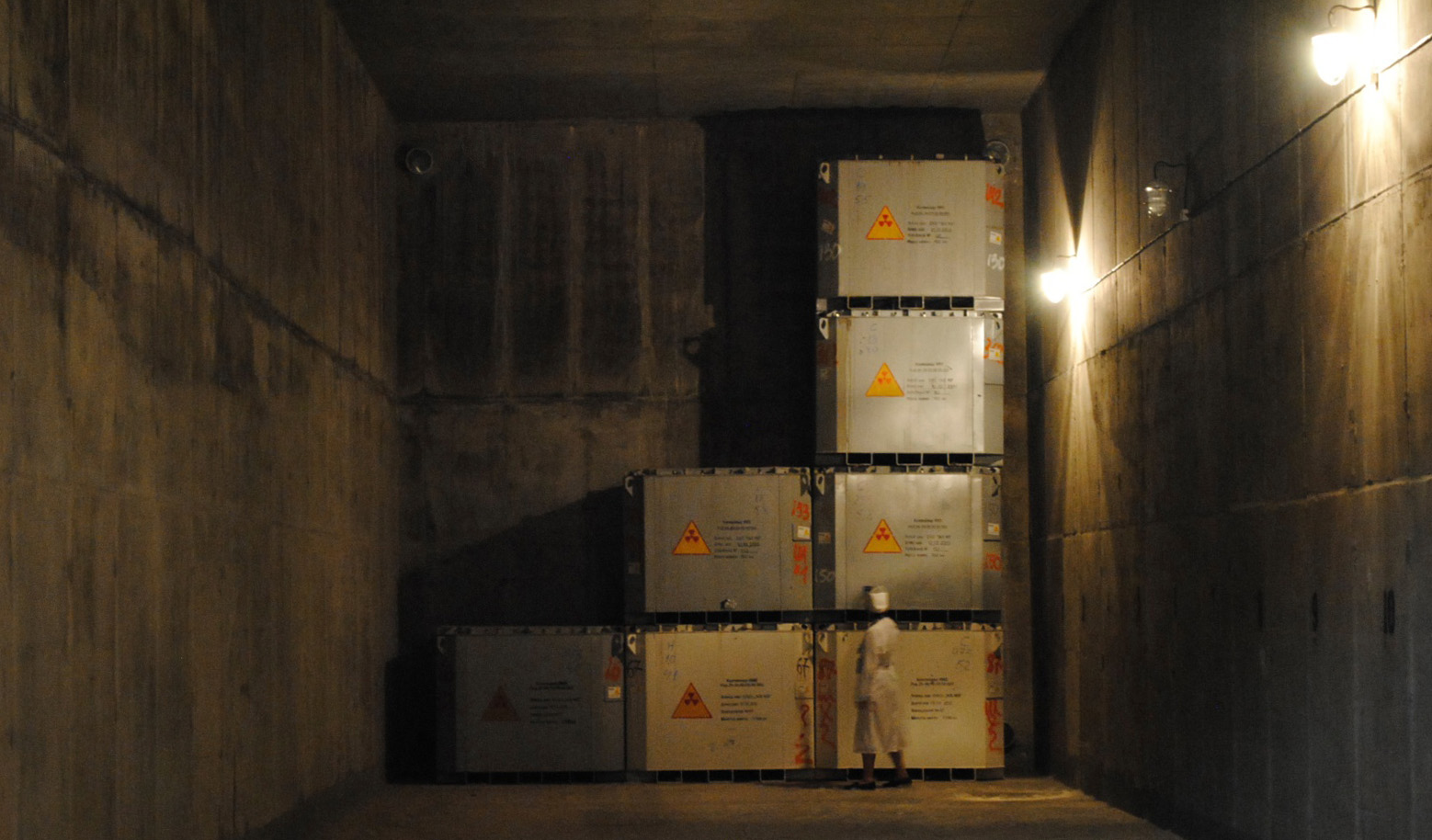
With the development of the nuclear industry and power engineering in the late 1950s of the USSR, nuclear technologies, radioactive materials and sources of ionizing radiation began to be used more and more in various fields - in science, medicine, in the non-nuclear industry. To ensure radiation safety, an urgent need arose to create a special structure that would collect and store radioactive waste generated in various “non-nuclear” organizations. It is important to note that we are talking about civilian radioactive waste - sources of radiation and radioactive waste of low and medium activity. Highly active waste from the nuclear fuel cycle and nuclear fuel have been and are being dealt with by specialized enterprises in closed cities.
As a result, a whole network of factories was organized, which received the name "Radon". From 1960 to 1980, 35 such factories were created throughout the USSR, from Kaliningrad to the Far East, 16 of which were located in the Russian Federation, 6 in Ukraine, and one in each of the former Soviet republics. This article is about the history of the first and head organization of this network, the Moscow plant "Radon".
A large number of organizations working with radiation were located in Moscow and the science cities of the Moscow region, so the first, largest and most advanced from a scientific and technical point of view was the Moscow "Radon", which was located in the city of Sergiev Posad. Work on the creation of "mailbox number 662" or the Central Station for Radiation Safety , as the object was called at different times, began in 1958. The site was chosen for several years, taking into account the geological features and clay soils, which make it impossible for radioactive contamination of groundwater even in the most incredible accident.
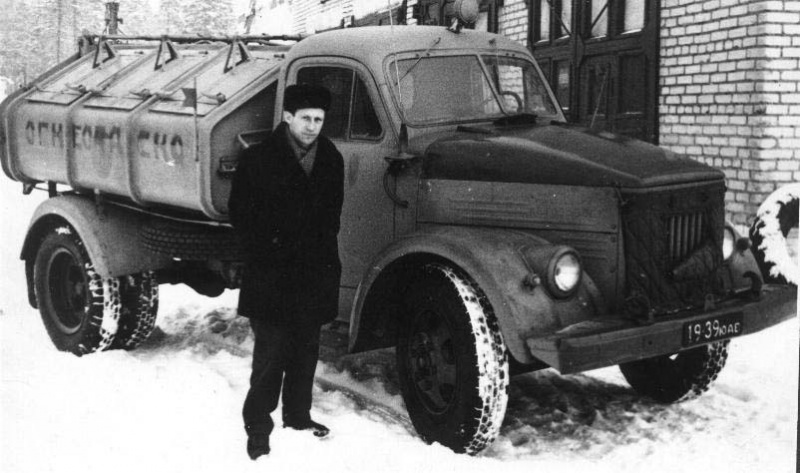
Driver A. T. Bystrov and vehicles of the first trip to transport radioactive waste to "mailbox No. 662" in January 1961. Source .
The first voyage of eight special vehicles for radioactive waste took place on January 27, 1961 to two objects - to the Kurchatov Institute and the Shchukin water treatment plant. Moscow "Radon" acted as a kind of experimental site, where technologies for radioactive waste management were developed and implemented, industry specialists were trained.
In 2008, 15 regional plants of the Radon network became part of the recently created state corporation Rosatom as branches of the newly formed structure of RosRAO. However, the Moscow "Radon" received a special status and remained under the jurisdiction of Moscow. He entered Rosatom only in 2013, but remained outside the structure of RosRAO. This was partly to keep the industry competitive.because RW processing is a service that is ordered on market conditions, and technologies grown in a competitive environment can be used abroad, in the backend market .
Nevertheless, the tasks of all the former Radon plants remained the same - collection, processing and storage of radioactive waste. It is important to note that many storage facilities at such facilities were built in the 1960s, in conditions of rather limited knowledge in the field of radioecology and environmental requirements that existed at that time. Despite the fact that many radioactive waste was accepted for disposal, many storage facilities did not provide safe isolation of waste for the entire period that they pose a threat and do not meet modern safety requirements.
With the adoption in 2011 of Federal Law No. 190 "On Radioactive Waste Management", the concept of radioactive waste management is changing in Russia and there is a requirement to prepare waste for final safe disposal, and not to transfer this issue to future generations. In 2011, a new structure was created - the National Operator for RW Management (FSUE NO RAO). Its tasks include the creation and operation of stations for the final isolation of radioactive waste, where they will receive waste from manufacturers at special rates for their safe disposal. At these points, waste will be reliably isolated from the access of people and the environment for periods of hundreds and thousands of years, while they pose a threat. The natural monopolist NO RAO is not engaged in either processing or transportation of radioactive waste - these services are still provided on a competitive basis by different organizations,the largest of which remain RosRAO and FGUP Radon.
«»
In the early 1960s, Radon was able to significantly unload local radioactive waste storage facilities at enterprises in Moscow and the Moscow region. In 1968, a huge main technological building was built. With the commissioning of the building, RW processing began by various methods with the aim of reducing them in volume and transferring them to a safe chemical and physical state - pressing, incineration, bitumenation. Until now, reducing the volume and bringing it into a solid and stable form are the main principles of radioactive waste processing, which make it possible to reduce the final volume of radioactive materials sent for disposal. By and large, only materials and technologies change. Later, more and more modern installations for the incineration of radioactive waste appeared at the enterprise, incl. plasma, pyrolysis, inclusion in bitumen, cement and glassy matrix.More and more modern and specialized storage facilities for radioactive waste and spent radiation sources were built.

Modern scheme of radioactive waste management at FSUE "Radon". Source
In addition to solving practical and scientific problems in the field of radioactive waste management, "Radon" is also engaged in monitoring the radiation situation on the territory of Moscow. On his website, you can always look at an interactive map of the current levels of external gamma radiation in Moscow and the Moscow region , collected from its own network of sensors. In addition, the plant participates in the decommissioning of nuclear facilities, which also generates a large amount of radioactive waste.
Currently FSUE "Radon" serves about 2500 organizationsand accepts radioactive waste generated as a result of the activities of industrial enterprises, scientific, medical, agricultural institutions, military units, as well as radioactive waste transferred by subdivisions of the Ministry of Emergency Situations of the Russian Federation from Moscow, Moscow, Arkhangelsk, Bryansk, Vladimirskaya, Ivanovskaya, Kaluga, Ryazan, Smolensk, Tverskaya, Tula and Yaroslavl. Thus, FSUE "Radon" serves an area with a population of over 40 million people.
Annually "Radon" receives about 3500-4000 m3 of RW, most of which is soil contaminated with radioactive elements and construction waste from decommissioned nuclear facilities or rehabilitated contaminated areas. For example, contaminated soil from the construction area of the South-East Expressway in Moscow will be removed here.... The processing of this waste at the enterprise will make it possible to significantly reduce its volume and prepare it for disposal in accordance with modern requirements.
FSUE "Radon" takes part in the elimination of the so-called nuclear legacy, i.e. accumulated radiation consequences and problems of the past. For example, it was "Radon" that received radioactive waste generated during the decommissioning of research reactors, nuclear installations and structures at the "Kurchatov Institute" or at JSC "VNIINM" in Moscow.
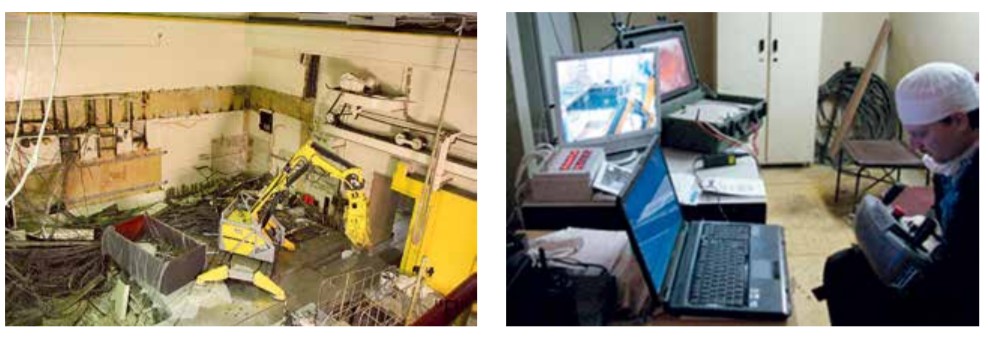
Remote organization of radiation hazardous work during decommissioning of the MR and RTF reactors at the Kurchatov Institute. Radioactive waste (about 2000 m3) was removed to FSUE "Radon". Source .
Within the framework of the current federal target program "Ensuring nuclear and radiation safety for 2016-2020 and for the period up to 2030" (FTP NRS-2) FSUE "Radon" also participated in solving the problems of the nuclear legacy of the Ministry of Defense of the Russian Federation. In particular, at two sites of the 12th Central Research Institute in Sergiev Posad, Moscow Region and Priozersk, Leningrad Region, work was carried out to bring facilities to a radiation-safe state and prepare them for decommissioning. As a result, the two-story structure of the Priozersk Radiobiological Laboratory (RBL), where they worked with open radioactive sources since the 1970s, was dismantled, and the territory was cleared.

Dismantling of radioactively contaminated buildings during decommissioning. Source .
Within the framework of the same FTP NRS-2 in the Moscow Region, work is now underway to decommission several buildings of NIIP JSC in Lytkarino. The institute created and tested nuclear installations and prototypes of nuclear reactors for aviation and space. Some of the reactors that have been operating for over 40 years have already been dismantled and disposed of. Currently, work is underway to decontaminate several workshops and premises. The radioactive waste generated as a result of the work is delivered to the FSUE "Radon".
In recent years, a significant amount of work by Radon is associated with the removal of radioactive wastefrom old storage facilities at nuclear power plants. Since 2018, the plant has been working with RAO Kursk, Novovoronezh and Smolensk NPPs. The task of the enterprise is reduced to the safe extraction, removal of waste from the NPP, bringing it into line with the acceptance criteria for disposal (ie, processing and appropriate packaging), with subsequent transfer to FSUE NO RAO for disposal. At the same time, "Radon" works only with low- and intermediate-level waste of the 3rd and 4th classes, and is not involved in work with spent nuclear fuel from nuclear power plants and other high-level materials. This is done by specialized nuclear fuel cycle plants in the Urals and Siberia.
New RW storage facility
A total of 41 RW storage facilities were built on the territory of FSUE "Radon". Only in 7 of them the radioactive waste is placed in conformity with modern requirements for transfer to the National Operator in conditioned form in certified containers. To date, the site's storage facilities are almost 90% full.
However, the National Operator for RW management does not yet have sufficient storage facilities to receive all RW accumulated in our country. However, you shouldn't be in a hurry - they still need to be processed and brought into a form suitable for burial. So far, NO RAO operates and accepts waste at only one site in Novouralsk, in the Sverdlovsk Region. In several regions, construction of other final isolation points for radioactive waste is underway.
Therefore, one more function is now assigned to the Moscow "Radon" - long-term temporary storage of radioactive waste, which will then need to be transferred to the National Operator for disposal. To date, Radon has accumulated about 12 thousand tons of radioactive waste, ready for disposal. The first batch of conditioned waste has already been transferred for disposal in October this year. This process should be accelerated with the commissioning of the second stage of the radioactive waste disposal facility in Novouralsk (at the end of 2020) and the radioactive waste disposal facility in Seversk and Ozersk (2021 and 2022, respectively).
Therefore, the most important area of work of FSUE "Radon" is the creation of a long-term temporary storage facility for RW of the 3rd and 4th classes - building 103, at its site in the Moscow region. The design of the new storage facility began in the 1990s and was carried out with the technical assistance of the European Union “within the TACIS program”. At the moment, construction of the first stage of the complex with a total volume of 55 thousand cubic meters. m is being completed under the federal target program FTP NRS-2.

New radioactive waste storage facility. The first 4 modules on the right are already in use. Source .
The main building of the first stage of the storage facility, building 103, has a size of 172.4 x 193.5 m, a height of about 6 m and will consist of 10 storage modules of the same volume and design. Each module is divided into 6 compartments with openings for loading with reinforced concrete and metal containers with radioactive waste using a forklift. The first 4 modules have been commissioned and operated since 2010. The remaining 6 are due this year.
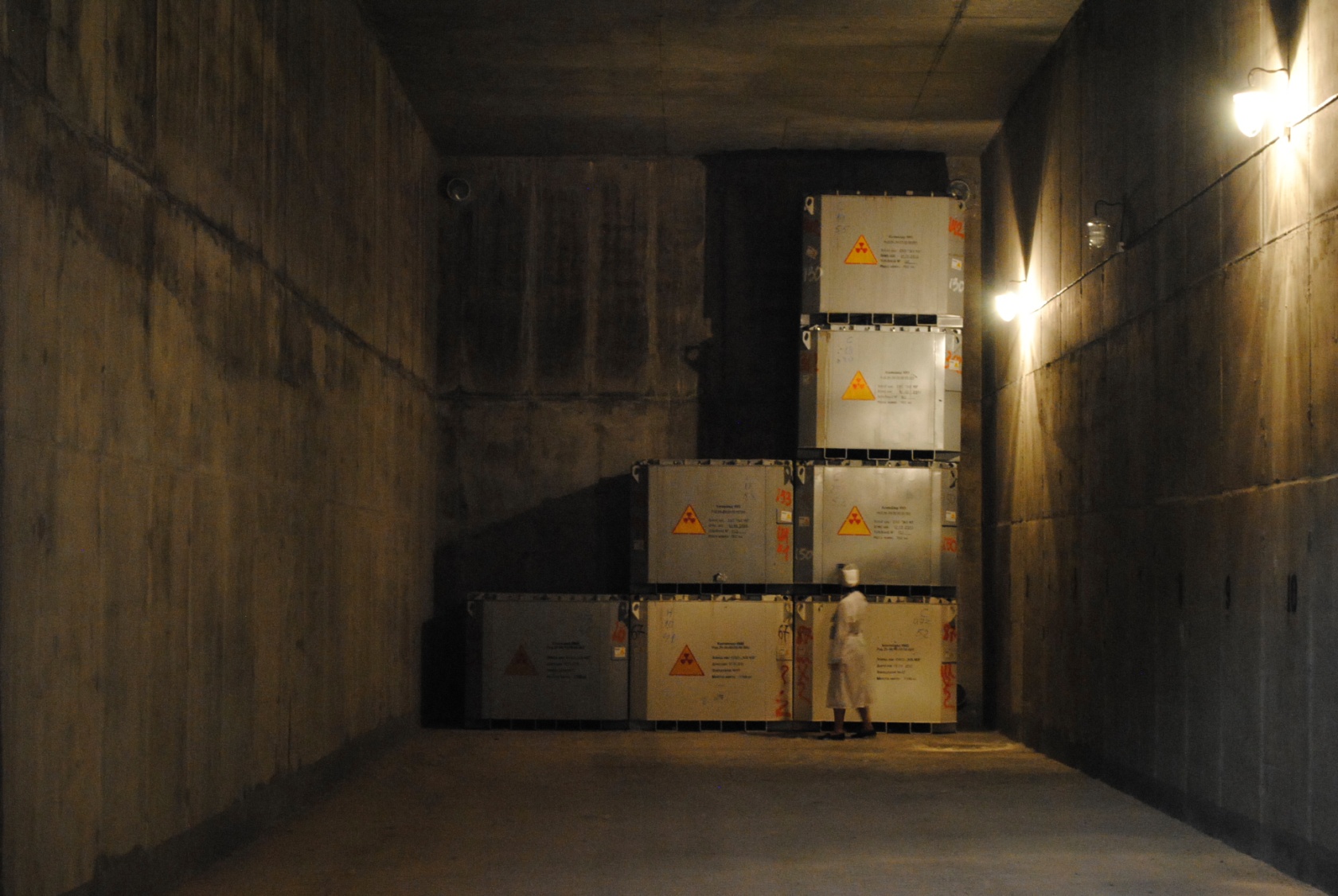
Containers with radioactive waste in the already operated part of the new storage facility in building 103. Source .
Only conditioned (processed and packaged) forms of radioactive waste obtained as a result of technological processing of contaminated objects and materials will be accepted for placement in the storage facility. The complex for processing and conditioning radioactive waste at FSUE "Radon" is now also being updated .
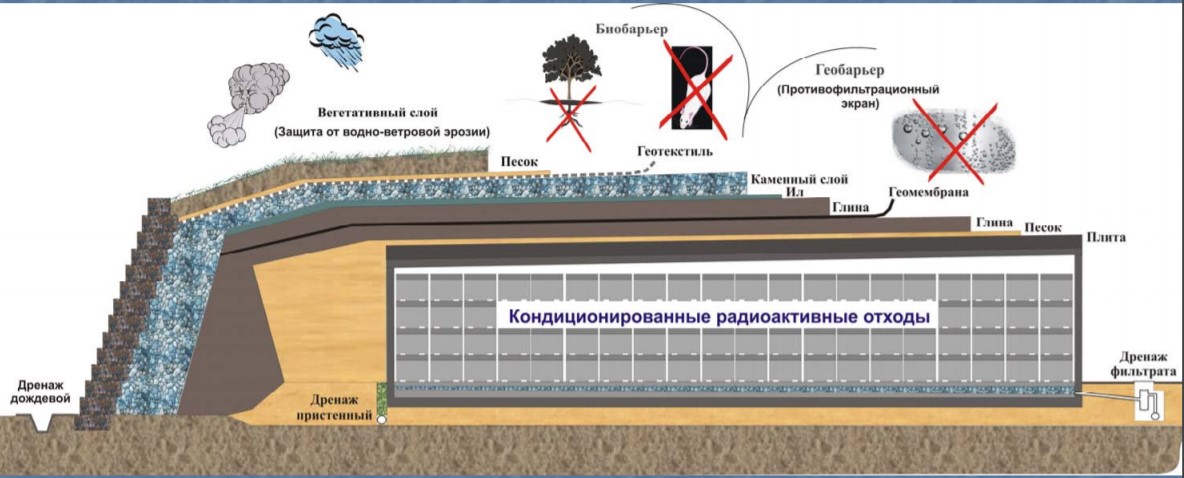
Conceptual scheme of conservation of the storage facility in case of its transfer to the RW disposal facility. Source .
The storage facility is designed for 50 years of operation, after which the remaining containers with radioactive waste will be removed and sent for disposal at NO RAO, or the storage itself will be mothballed and converted into a radioactive waste disposal facility. In fact, the existing RW disposal facilities, which are being built by the National Operator for RW Management, are similar in design, so it will not be difficult. If a decision is made to transform the structure into a radioactive waste disposal facility, the compartments with containers will be filled with additional buffer material, and the structure itself will be additionally isolated from the environment with a multilayer screen, preventing its flooding. Such a disposal facility is designed for 300-500 years of service, therefore, before conservation, it will be filled only with RW of the 3rd and 4th classes, containing only radionuclides with a half-life of no more than 30 years.which will decay in 300 years.
Sources used:
1. Substantiation materials for the license for the right to operate radiation sources and a radioactive waste storage facility (including materials for assessing the impact on the environment). Volume 1. FSUE "Radon"
2. Modern approach to radioactive waste. Interview with the general director of "Radon" Alexey Luzhetsky.
3. First discussions of the activities on radioactive waste management by FSUE "Radon". Bellona Report, 2016.
4. Eliminating Nuclear Legacy: 2008-2015.
5. Technologies for handling radioactive waste during decommissioning of research reactors MR and RFT .